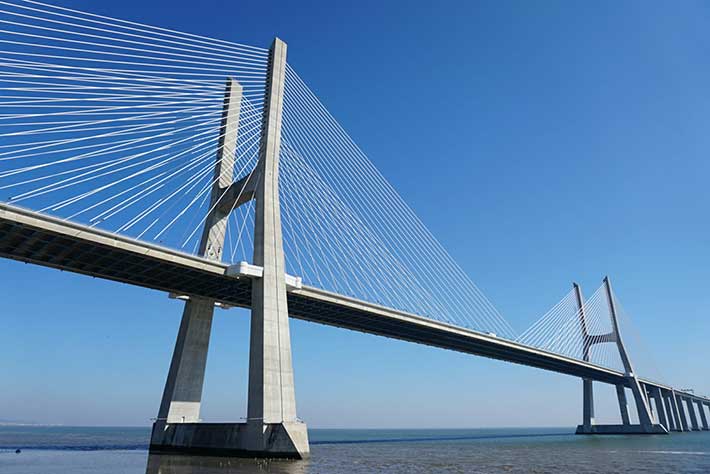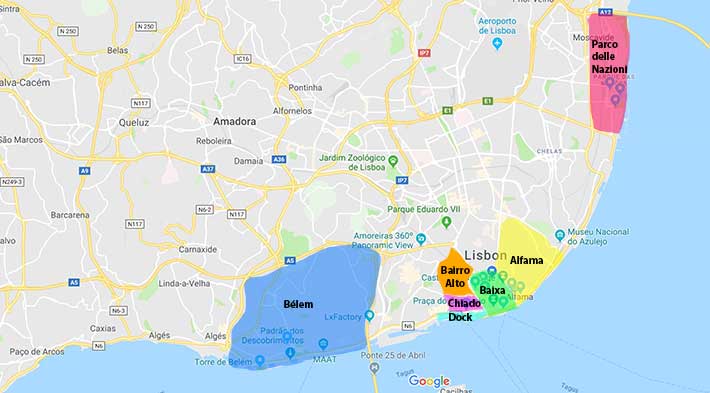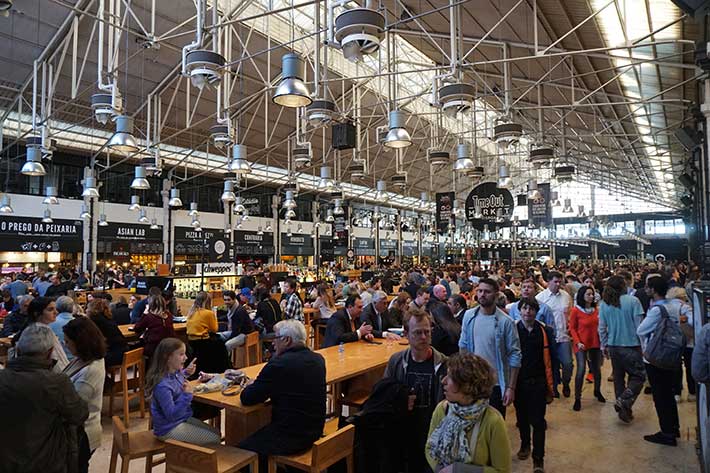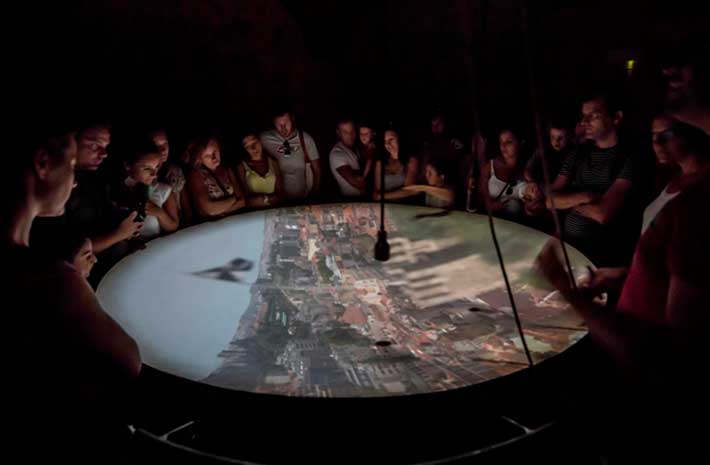The neighborhoods of Lisbon to visit are each a small world unto themselves: each has its own soul, its own history, and its own life. Be prepared to walk for miles – I covered 120 kilometers in one week.
I must admit, from the very first evening Lisbon surprised and captivated me: for the local people, for the organization, for the cleanliness, for the architecture, and for the open spaces. It’s a human-scale city, where people get around on foot or by public transport and where it’s still a pleasure to stroll through its unchaotic streets, encountering many green spaces both in the center and along the banks of the Tagus.
To visit the city, you need to take your time – I’d say roughly one day per neighborhood. A week in Lisbon allows you to visit the main 5 neighborhoods and take the two day trips to Sintra and Cascais.
The neighborhoods of Lisbon that you absolutely must visit can be discovered using the famous tram 28, by metro, or even better on foot. I highly recommend wearing good hiking shoes, also because the limestone calçada used for the sidewalks is slippery, even more so when they start cleaning them with water cannons! 🙈
The Bairro Alto Neighborhood
Bairro Alto is Lisbon’s most creative and authentic neighborhood, where history, artists, galleries, and folklore are at home. During the day it’s quiet, but in the evening it comes alive and the nightlife becomes vibrant.
There are two funiculars that lead to the neighborhood: the Elevador da Glória north of Rossio station and the Ascensor da Bica right behind the Mercado da Ribeira Nova.
Don’t miss the panoramic viewpoint Miradouro de São Pedro de Alcântara, from where you can admire the Baixa neighborhood and the Castelo de S. Jorge.
Baixa, Chiado and the Docks
Symbol of the city’s rebirth, Baixa is a central neighborhood of Lisbon that extends from Rossio to the river, with elegant pedestrian streets and squares. Here you’ll find the major shops and during the day it’s among the busiest in the city. The neighborhood was rebuilt after the 18th-century earthquake by the Marquis of Pombal. Towards the Tagus River you’ll find Praça do Comércio and the Arco da Rua Augusta.
While wandering around Lisbon, you can’t help but taste Ginjinha, a sour cherry liqueur that’s sweet and spicy at the same time, typical of the area. You can taste it in various places, but the most characteristic and historic remains Ginjinha Espinheira, in Largo de São Domingos.
In the Baixa neighborhood are hidden shops dating back to the early 1900s and even earlier, where these commercial establishments have preserved their original furnishings. Don’t miss Confeiteraria Nacional, a pastry shop active since 1829; Manuel Tavares, a grocery store founded in 1860; Retrosaria Bijou, a haberdashery opened in 1922; Luvaria Ulisses, a glove shop from 1925.
Chiado is a small traditional and characteristic neighborhood of Lisbon. Once a meeting place for writers and intellectuals, today it’s an elegant area where you can shop or have a drink in one of the many establishments.
Along the docks, the old port wharves on the Tagus, everything has been renovated. The former warehouses once used by importers of exotic goods have been converted into nightclubs, restaurants and trendy bars, as well as some design shops. Opposite Cais de Sodré station, where bus, train, tram, metro and ferry lines meet, we find the Mercado da Ribeira, a renovated metal and glass structure that houses the wholesale food market and the Time Out Market, an area where you can find various restaurants, bars and shops. It’s definitely a place to visit and stop for lunch.
Alfama
Alfama is one of the neighborhoods of Lisbon to visit: it’s actually the most popular in the Portuguese capital, the neighborhood of narrow streets and daytime tourist visits. The first thing to visit is definitely the Castelo de S. Jorge, not so much for the structure, but rather for its position that dominates the city and thanks to which it offers an unmissable 360° view. In one tower of the castle there’s the “camera obscura“, which I recommend going to see, even though you need to queue a bit.
To see the castle it’s better to arrive between 9:00 and 11:00, because when I left at noon there was a line at the ticket office of at least 30-45 minutes.
In the Alfama neighborhood you can find various interesting graffiti and see various buildings with the famous “azulejos“, the typical Portuguese ceramics, which became famous following the arrival of the Moors in the country.
Bélem
The Bélem neighborhood is far from the center, but still well connected by train and tram 15. Don’t go on Mondays, because several attractions are closed. Important expeditions that brought conquests to Portugal departed from this neighborhood and it therefore has a certain importance for the city. In Bélem there are 3 important points of interest: the Monasteiro dos Jerónimos, the Torre de Belém and the Monument to the Discoveries dedicated to Henry and his navigators. Another point of interest little mentioned in guides is the Maat, the museum of art, architecture and technology. If these are subjects of interest, it’s worth entering and visiting both buildings.
Before returning to the center don’t forget to go and try the original “Pastel de Bélem” at the bakery of the same name.
Nations Park (Parque Das Nações)
The Nations Park is the neighborhood of modern Lisbon. Before its redevelopment, it was in a state of decay and abandonment: outdated industrial complexes, old military depots, a disused slaughterhouse and an open-air dump. Thanks to the fact that it was chosen for the 1998 International Exhibition (Expo ’98), the area underwent major redevelopment and since then became part of the life of Lisbon’s inhabitants. Today this area is the most privileged and expensive to live in Lisbon.
It’s definitely worth taking a walk along the banks of the Tagus to admire the Vasco de Gama bridge, which at 17.2 km is the longest bridge in Europe. Nearby is the Vasco da Gama Tower, 140 meters high, designed as a panoramic tower, now converted into a luxury hotel. Both were built for Expo 98.
The Parque das Nações also preserves other buildings and former pavilions that were built specifically for the exhibition: from the Pavilhão Atlantico to the Oceanario (one of the largest and richest aquariums in the world), not forgetting the Pavilhão do Conhecimento, the Pavilhão de Portugal, designed by the famous Portuguese architect Alvaro Siza Vieira and the Pavilhão do Futuro, now converted into a Casino.
The neighborhood is reachable via the red metro line that runs from São Sebastião to the airport.
For meat lovers, in the area I can recommend the Butchers restaurant, located right behind the Casino.
Tips |
|
For staying overnight in Lisbon I find that the best way is to get an apartment through Airbnb. On this map you can see the most interesting points of interest, restaurants, and tourist attractions in Lisbon. To get around the city I used the metro and walked a lot on foot, which allowed me to discover hidden corners of the city. On the metro website you can find all the information regarding the various ticket offers. There are combined tickets for all public transport over several days. Throughout my stay in Lisbon I found only one negative note: the drug dealers present in neighborhoods heavily frequented by tourists like Chiado and Baixa, who even during the day continue to approach trying to sell any type of drug (and they don’t limit themselves to soft drugs); all this despite the strong police presence in the city streets. They’re not insistent, just ignore them and they go away, but it’s annoying and certainly not a good calling card for Lisbon. |
Check out the other articles on Lisbon.
Subscribe to the blog so you don’t miss the next articles!
Last update:









